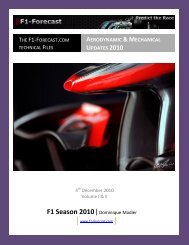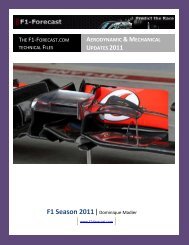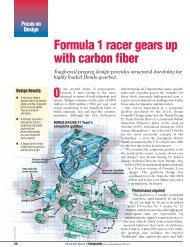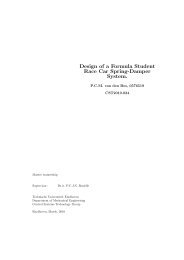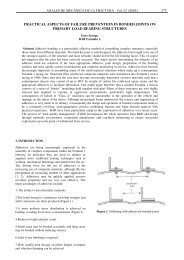Formula 1 Race Car Design Takes Finite Element Analysis.pdf
Formula 1 Race Car Design Takes Finite Element Analysis.pdf
Formula 1 Race Car Design Takes Finite Element Analysis.pdf
You also want an ePaper? Increase the reach of your titles
YUMPU automatically turns print PDFs into web optimized ePapers that Google loves.
<strong>Formula</strong> 1 <strong>Race</strong> <strong>Car</strong> <strong>Design</strong> <strong>Takes</strong> <strong>Finite</strong> <strong>Element</strong><br />
<strong>Analysis</strong><br />
To the Next Level<br />
By Dennis Sieminski, P.E.<br />
<strong>Formula</strong> 1 or Grand Prix racing is<br />
known for its extensive use of advanced<br />
technology, huge monetary investment,<br />
and the attention-grabbing looks of its<br />
highly aerodynamic, open-wheeled race<br />
cars. According to F1 rules, each team<br />
must design and build its own car. This<br />
typically requires an investment<br />
upwards of $1 million for each car and<br />
an annual race team budget that can run<br />
in the $100s of millions. The races are<br />
very technologically demanding because<br />
of the high speeds (cars are capable of +200mph lap speeds), multi-turn paved courses,<br />
and the fact that races are run under all weather conditions in a variety of venues around<br />
the globe. Plus the schedule is intense, with the F1 program typically involving 17 races a<br />
year.<br />
Technology and Talent Provide the Edge<br />
The Minardi <strong>Formula</strong> 1 <strong>Race</strong> Team is not the biggest of the <strong>Formula</strong> 1 racing teams, but<br />
that is exactly what provides the motivation for them to find and exploit technologies that<br />
can neutralize this disadvantage. Since its founding by Gian <strong>Car</strong>lo Minardi in 1979, the<br />
Minardi Team, based in Faenza, Italy, has imprinted its unique spirit-in-the-face-ofadversity<br />
character on this extremely challenging sport, bringing an instinct for<br />
innovation and eye for talent. One example of Minardi innovation is the introduction of<br />
the titanium gearbox in 2000. In the talent department, Minardi lays claim to grooming a<br />
number of well known drivers, such as Fernando Alonso, who started with them in 2001.<br />
A Search for FEA Simulation Capable of Replacing Prototyping and Testing<br />
In 2004, Minardi began to study how it could improve the structural design of its <strong>Formula</strong><br />
1 race cars. An important aspect of this program was determining how they could<br />
enhance the chassis for safety and performance without incurring the massive costs that<br />
prototyping and physical testing in their design process imposed. While Minardi had been<br />
using <strong>Finite</strong> <strong>Element</strong> <strong>Analysis</strong> (FEA) software for many years, the team members felt<br />
they were not getting the full potential from the technology. The team began a six month<br />
test with Noran Engineering’s CAD-independent NEiNastran with the objective of<br />
improving the analysis and simulation results in a way that would significantly reduce the<br />
huge investments they were making in physical prototypes.<br />
The chassis design is quite unique. Paolo Mirabini, Manager of Minardi’s CAE Group,
offers an excellent summary of the multi faceted demands on this component: “The<br />
chassis has to end up with the smoothest and flattest shape possible within the many<br />
engineering constraints which exist. These constraints include desired wheelbase, engine<br />
interface, desired fuel capacity, aerodynamic requirements, and even the driver<br />
dimensions!<br />
To complicate matters, the construction details used in assembling the chassis also affect<br />
its design." That is because the chassis is a<br />
monocoque structure made of high<br />
performance carbon-epoxy composites with<br />
either an aluminum or aramidic honeycomb<br />
core. The fibers within the materials have to<br />
be oriented according to the design, and not<br />
bend, while the ply overlapping and<br />
necessary cuts are minimized. Getting any<br />
of these aspects wrong can affect the<br />
performance of the chassis.<br />
Once a design concept is in place,<br />
modifications and further evolution<br />
continuously interplay with the very<br />
stringent safety requirements for the chassis with the safety regulations becoming the<br />
overriding driving force in the design process.<br />
Physical Testing Validates the Simulations with NEiNastran<br />
There are 15 Impact tests the F1 chassis must survive. Being able to simulate them<br />
correctly in a finite element analysis<br />
environment has the potential to save an<br />
enormous amount of time, money, and<br />
resources in prototyping and testing. In<br />
addition, such a process allows Minardi<br />
engineers to optimize the design and gain<br />
an edge on the race course. Again the<br />
words of Paolo Mirabini offer the best<br />
testament to the demands on the software<br />
simulation: “We tested the 3D model in<br />
NEiNastran with more than 15 impact<br />
tests, including side crash, crash cone<br />
push-off tests and more. The software<br />
surpassed our expectations – and those<br />
expectations are very high.”<br />
Following is a brief description of several of the Impact and Performance Tests to which<br />
Mirabini is referring. These provide a sense of the power, precision, and accuracy that is<br />
required in the engineering analysis software to produce a useful simulation.
Side Crash - This is the most demanding test. A 780Kg cart impacts the side of the<br />
chassis at 10 m/s, and lateral crash appendices (called Crash Cones) are measured, which<br />
include maximum deceleration and maximum force on a cone. Each cone has to take<br />
from 15-35% of the total energy, and no damage can be found on the chassis.<br />
Penetration Test - A square flat plate with the same layout of the chassis in the side area<br />
is quasi-statically penetrated with an aluminum conical impactor until a penetration of<br />
1500 mm is measured. The model must respond to absorbed energy >6000 J, and reaction<br />
load >250kN.<br />
Main Roll Bar Crush - The roll bar is statically pushed with a force of about 120kN via<br />
an inclined plate, impacting the main roll-bar top. Requirements are that deformation is<br />
less than 50mm, and the damaged area must be within 100mm from the load application<br />
plate.<br />
Front Roll Bar Crush - The front roll bar is a reinforcing structure located just behind the<br />
steering wheel. A similar test as in the Main Roll Bar Test is made with a 75kN vertical<br />
force.<br />
Lateral Local Crushes - Several specific locations of the chassis side have to be loaded<br />
with forces varying from 12.5kN to 30 kN. Maximum displacements and no damage<br />
requirements are prescribed.<br />
Torsional Stiffness - Each team has developed its own tradition for desired torsional<br />
stiffness ranging from 15,000 – 40,000 N M/o<br />
Flexural Stiffness - This test is made to check that the rear wall of the chassis is stiff<br />
enough to avoid a "hinge effect" at the interface with the engine, where there is a very<br />
high stiffness change.<br />
All of the tests above were simulated in the NEiNastran analysis environment and most<br />
were able to be replicated very closely. However, there are a few exceptions that require<br />
different handling. For example, the Penetration Test uses a simplified correlated<br />
calculation validated by years of experimental data that was developed within Minardi.<br />
The team used NEiNastran to<br />
simulate these tests, checking static<br />
analysis, buckling and surface<br />
contact. All calculations were<br />
correlated with experimental<br />
measurements. This enabled a<br />
continuous refinement of<br />
methodologies and material data.<br />
During the testing, several<br />
optimization routines were<br />
executed involving modifications
on material choice, layup sequences, local reinforcements, foams, bulkheads, and inserts.<br />
In these optimization exercises, NEiNastran proved flexible enough to manage the<br />
existing model while solving various alternates thrown at it providing highly detailed and<br />
accurate post-processing information. In this way, the effects of the modifications were<br />
able to be well understood by the engineers.<br />
Software Features and Strong Tech Support Make a New <strong>Design</strong> Process Possible<br />
Minardi worked with Noran Engineering’s Master European Distributor SmartCAE in the<br />
evaluation and implementation of NEiNastran. After the six-month evaluation, the<br />
Minardi team was satisfied that a number of key benefits would be achieved with a<br />
software change. In late 2004, the Minardi Team made the change official and switched<br />
to NEiNastran. Following are several factors the Minardi F1 Team said were instrumental<br />
in their decision to change:<br />
• Faster and better designs. The amount of prototype testing could be reduced<br />
significantly because the accuracy of results using NEiNastran’s Surface Contact feature<br />
was an improvement over the previous method. Similarly, the nonlinear analysis setup<br />
and solution finding also proved far more robust than their former software.<br />
• Fast implementation. An excellent training program combined with timely support from<br />
Noran Engineering allowed the new software system, NEiNastran, NEiAdvanced<br />
Composites and Smart/Browser to be implemented and used by the Minardi team within<br />
a matter of weeks.<br />
• Access and use of legacy data. The system was designed to enable bi-directional access<br />
to legacy and new data without any compatibility issues.<br />
• Reduced 3D modeling time. The creation of the FE model of the chassis was achieved<br />
in about half the time compared to previous software because of the power inherent in the<br />
NEiModeler (FEMAP) Pre and Post Processor which includes the modules NEiAdvanced<br />
Composites and Smart/Browser.<br />
Conclusion<br />
The performance of Minardi’s new cars in the upcoming <strong>Formula</strong> 1 season will of course<br />
have the attention of its race fans. But other <strong>Formula</strong> 1 <strong>Race</strong> Teams will also be looking<br />
with a critical eye. They will want to know whether Minardi’s knack for finding a new<br />
technical edge might be at work again, and if this means they may need to tune up their<br />
FEA software.<br />
Visit the Noran Engineering website to check out other case studies from innovative<br />
companies and learn more about NEiNastran. Information on the Minardi <strong>Formula</strong> <strong>Race</strong><br />
Team can be found at the Minardi FI Team website. See SmartCAE website for<br />
additional information on that product.<br />
Dennis Sieminski is responsible for directing the marketing programs at Noran Engineering and works<br />
with a network of international dealers on customer support and the development of new applications and<br />
business. Mr. Sieminski's academic credentials include engineering and business degrees, as well as a
professional engineer's license. His previous work experience and background in product development in a<br />
range of industries provides him with a hands-on appreciation for the role and benefits of design, analysis,<br />
and simulation software.



